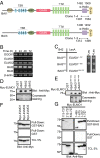G-protein coupled receptor BAI3 promotes myoblast fusion in vertebrates
- PMID: 24567399
- PMCID: PMC3956190
- DOI: 10.1073/pnas.1313886111
G-protein coupled receptor BAI3 promotes myoblast fusion in vertebrates
Abstract
Muscle fibers form as a result of myoblast fusion, yet the cell surface receptors regulating this process are unknown in vertebrates. In Drosophila, myoblast fusion involves the activation of the Rac pathway by the guanine nucleotide exchange factor Myoblast City and its scaffolding protein ELMO, downstream of cell-surface cell-adhesion receptors. We previously showed that the mammalian ortholog of Myoblast City, DOCK1, functions in an evolutionarily conserved manner to promote myoblast fusion in mice. In search for regulators of myoblast fusion, we identified the G-protein coupled receptor brain-specific angiogenesis inhibitor (BAI3) as a cell surface protein that interacts with ELMO. In cultured cells, BAI3 or ELMO1/2 loss of function severely impaired myoblast fusion without affecting differentiation and cannot be rescued by reexpression of BAI3 mutants deficient in ELMO binding. The related BAI protein family member, BAI1, is functionally distinct from BAI3, because it cannot rescue the myoblast fusion defects caused by the loss of BAI3 function. Finally, embryonic muscle precursor expression of a BAI3 mutant unable to bind ELMO was sufficient to block myoblast fusion in vivo. Collectively, our findings provide a role for BAI3 in the relay of extracellular fusion signals to their intracellular effectors, identifying it as an essential transmembrane protein for embryonic vertebrate myoblast fusion.
Keywords: RhoGTP; ced-12; model system; myogenesis; myotube formation.
Conflict of interest statement
The authors declare no conflict of interest.
Figures




References
-
- Powell GT, Wright GJ. Do muscle founder cells exist in vertebrates? Trends Cell Biol. 2012;22(8):391–396. - PubMed
-
- Ruiz-Gómez M, Coutts N, Price A, Taylor MV, Bate M. Drosophila dumbfounded: A myoblast attractant essential for fusion. Cell. 2000;102(2):189–198. - PubMed
-
- Strünkelnberg M, et al. rst and its paralogue kirre act redundantly during embryonic muscle development in Drosophila. Development. 2001;128(21):4229–4239. - PubMed
Publication types
MeSH terms
Substances
Grants and funding
LinkOut - more resources
Full Text Sources
Other Literature Sources
Molecular Biology Databases
Research Materials
Miscellaneous

